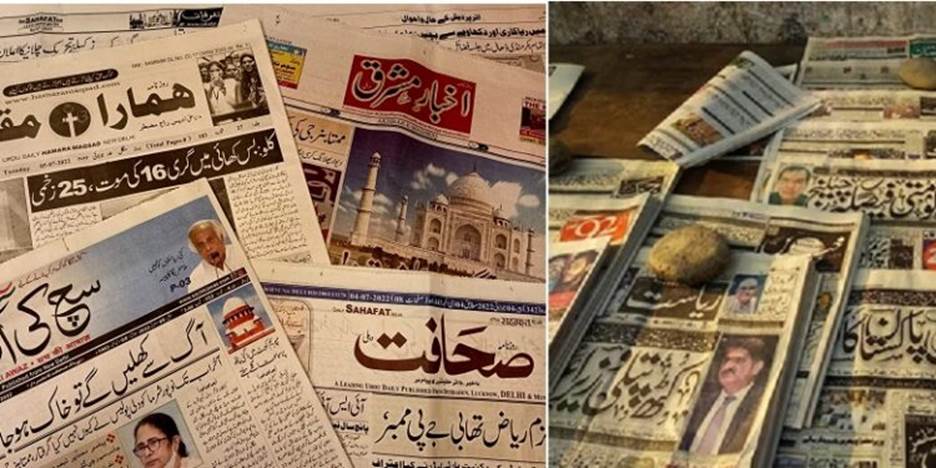
Two Centuries of Urdu Journalism and Its Impact on Society
By Siraj Khan
Boston, MA
I strongly believe that the milestone of 200 years of Urdu journalism did not get the extent of attention that it truly deserved in the year 2022. Throughout a fascinating and enlightening history, Urdu language journalists have made everlasting sacrifices for the independence of the Indian Subcontinent from the iron grip of the British empire, and the last 75 years as three independent countries of South Asia. Through this humble offering, I am scrambling to do my bit before this year is over, primarily to pay tribute to all those who are helping to keep the torch lit in a storm.
Going back through the unfolding process, what has become evident is that Urdu was never the language of Muslims alone, as is generally believed. It would be a surprising revelation to many that the first newspaper in Urdu language in the Indian Subcontinent was launched not by a Muslim, but by a Bengali Brahmin Hindu Harihar Dutta as founder/publisher and a Punjabi Sadasukh Lal as editor. The printer was a British national, William Hopkins, an employee of the East India Company. The weekly Jam e Jahan Numa was first published from Calcutta on 27 March 1822. Hence, right from inception, non-Muslim Indians published most of the Urdu newspapers. Even the editors of most of the Urdu newspapers of 19th century were non-Muslims. This fact itself has been the hallmark of Urdu journalism, reflecting its secular characteristics.
When the Government allowed publication after amending the Press Act in 1834, journalist Moulvi Muhammad Baqar started taking out his weekly newspaper under the name of Delhi Urdu Akhbar ( دہلی اردو اخبار ). The paper survived for nearly 21 years, proving to be a milestone in the field of Urdu journalism. This newspaper played a key role in projecting social issues as well as bringing political awakening in the public and uniting both Muslims and Hindus against the British rule. The mutiny against the British was sparked by sepoys in 1857 and spread like wildfire. Moulvi Muhammad Baqar was arrested on 14 September 1857 for revolt. He was executed without trial on 16 September 1857 by the British, making him the first martyr of Urdu journalism.
That did not stop Urdu from becoming the language of the freedom movement. From Bhagat Singh, Lala Lajpat Rai, Kartar Singh Sarabha to Ram Prasad Bismil Azimabadi everyone used Urdu as their language to reach out to the masses during the struggles of the freedom movement, amidst very stiff fines on publishers from the colonial authorities. Urdu became the chosen language of the Arya Samaj, the Bengal Renaissance writers and also had Sikh devotional verses written in it. Lala Lajpat Rai had brought out his nationalist newspaper Vande Mataram in Urdu and the famous Indian syndicated columnist, human rights activist and left-wing political commentator Kuldip Nayar started his journalistic career as Urdu press reporter. By then, if any news was to be taken seriously, it had to be covered by an Urdu paper.

Then and now
Today we find Urdu newspapers in circulation not only in Pakistan and India, but even from Western and Persian Gulf countries. Technologically, Urdu journalism is also at par with other vernacular journalism. The advent of web technology helped Urdu journalism to make it global.
India, the birthplace of Urdu journalism, has witnessed the digitization of Urdu newspapers in the 21st century. The number of Urdu newspapers going on the web continues to increase, despite the ideological shift to Hindi.
In its 200 years, Urdu journalism has seen many ups and downs, and yet it meets all the requirements of its times and continues to quench the intellectual needs of its loyal readers. 40+ newspapers on each side of the Radcliffe Line tell it all.

Looking ahead
I believe that Urdu journalism’s future lies in going digital and audio-visual. The number of those who understand Urdu is way more than those who can read it, and these Urdu-lovers are spread across the globe, belonging to all faiths. The investment needed to set up an Urdu news portal which has all the features of a newspaper is also affordable. The future of Urdu journalism clearly lies in going “hybrid,” as newspapers need to have both print and digital editions.
To keep Urdu journalism alive, Urdu as a language must survive. It is up to us to preserve the language by making it a point to speak Urdu at home, and avoid the temptation of using replacement words from English. But even if Urdu-speaking Muslims were to fail in their duty, I am confident that Urdu would still survive, even if some people use Roman Urdu in script to get by.
After all, Rekhta has not been established by Urdu-speaking Muslims. Founded by Sanjiv Saraf in 2013, Rekhta is a web portal dedicated to the promotion of Urdu literature, claiming to have the world’s largest collection of Urdu poetry. So, if there is one takeaway, it would be this: the Urdu language does not belong to Muslims or to Pakistan alone.
I salute each Urdu journalist who has sacrificed their life to bring us to this milestone of 200 years and we must all collectively work to keep Urdu media in the mainstream and its torch always lit for the generations that are to come after us.
Some interesting facts and extracts from the history of Urdu journalism




